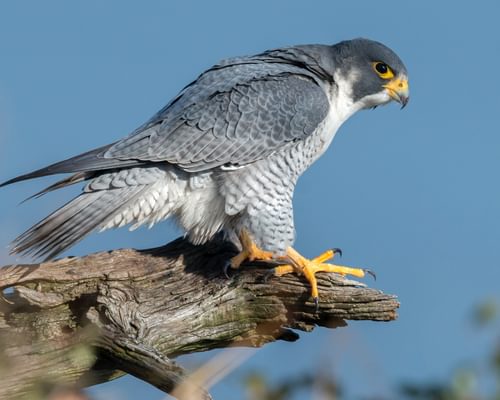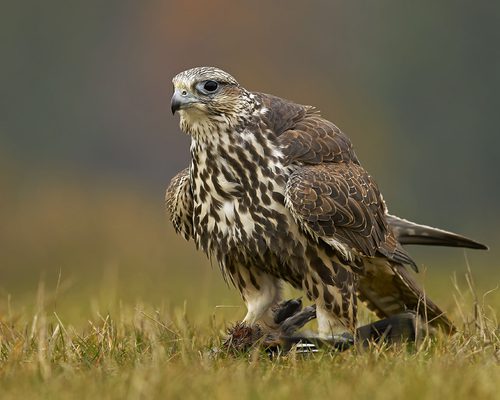Lanner Falcon
Least ConcernFalco biarmicus
Visual Identification
Appearance
The Lanner Falcon is a medium-sized raptor with a sleek, streamlined body. It features a brown-grey back, pale underparts with dark spotting, and a distinctive 'moustache' marking on its face. The wings are long and pointed, ideal for high-speed flight.
Females are noticeably larger and heavier than males, with darker overall plumage. Juveniles have a more streaked appearance, with brownish upperparts and heavily marked underparts. The distinctive facial pattern develops as they mature.
Size
Length
43cm to 50cm
Wingspan
95cm to 105cm
Weight
500g to 900g
Habitat and Distribution
Habitats
Woodland
Garden
Wetland
Coastal
Urban
Farmland
Grassland
Desert
Tundra
Rainforest
Mountain
Savanna
Distribution
Lanner Falcons inhabit a wide range of open and semi-open environments, including savannas, steppes, and mountainous regions. They are found across Africa, parts of southern Europe, and the Middle East, adapting to diverse landscapes from sea level to high altitudes.
In Europe, they are most commonly seen in Italy and Greece. There are occasional sightings in the UK, typically involving escaped falconry birds rather than wild populations.
Elevation Range
Up to 2,500 meters
Climate zones
Temperate, Subtropical, Tropical
Distribution Map
This map gives you a rough idea of where you might spot a Lanner Falcon. The coloured areas show countries where these birds have been seen.
A few things to keep in mind:
- Birds might not be everywhere in the coloured areas, for example, they may be present around the coast of that country
- Where birds live can change with seasons and available food
- This map is quite simple - it doesn't show exact locations
We're working on making our maps even better! Soon, we hope to show you:
- More detailed maps for bigger countries, including state and region
- How birds move around during different seasons
Distribution by Region
Behaviour and Ecology
Bird Attributes
This feature is in beta. We'd love your feedback to improve it!
Share your thoughtsBird Attributes Explained
Our bird attributes system rates various aspects of a bird's capabilities on a scale of 0-100, based on data from field observations, scientific studies, and expert knowledge.
Attribute Categories:
- Agility: Manoeuvrability, speed, and grace in flight or movement.
- Strength: Physical power, often correlating with size and hunting abilities.
- Adaptability: Ability to thrive in various environments or changing conditions.
- Aggressiveness: Territorial behaviour and assertiveness, particularly during breeding seasons.
- Endurance: Stamina, often seen in migration patterns or foraging behaviours.
Understanding the Ratings:
- 0-20: Very Low
- 21-40: Low
- 41-60: Average
- 61-80: High
- 81-100: Very High
Remember, these attributes are relative to other bird species and don't necessarily indicate superiority.
Hover over the icon next to each attribute for more information.
Tap the icon next to each attribute for more information.
Agility
Reflects the bird's manoeuvrability, speed, and grace in flight or movement.
The Lanner Falcon exhibits exceptional agility, capable of swift, precise movements in flight. Their ability to perform spectacular aerial displays during courtship and execute high-speed hunting manoeuvres, including stooping from great heights, demonstrates remarkable aerial prowess.
Strength
Indicates the bird's physical power, often correlating with size and hunting abilities.
As medium-sized raptors, Lanner Falcons possess considerable strength relative to their size. Their ability to capture prey in flight, including medium-sized birds like pigeons, indicates robust physical power. However, they are not as large or powerful as some other raptor species.
Adaptability
Represents the bird's ability to thrive in various environments or changing conditions.
Lanner Falcons show high adaptability, thriving in diverse habitats from sea level to 2,500 metres elevation. Their ability to hunt cooperatively and utilise various hunting techniques demonstrates behavioural flexibility. They also adapt well to different prey types, including birds, bats, and insects.
Aggressiveness
Measures the bird's territorial behaviour and assertiveness, particularly during breeding seasons.
While not overly aggressive towards humans, Lanner Falcons display considerable aggression in hunting and territorial behaviour. Their sharp, repetitive calls during breeding season and their bold hunting tactics, including cooperative hunting, suggest a moderately aggressive nature for a bird of prey.
Endurance
Reflects the bird's stamina, often seen in migration patterns or foraging behaviours.
The Lanner Falcon's endurance is impressive, as evidenced by their ability to engage in long periods of soaring and high-speed pursuit flights. Their partial migratory behaviour and capacity to hunt over wide areas also indicate strong endurance. However, they may not match the extreme long-distance capabilities of some other migratory raptors.
Diet
Lanner Falcons primarily hunt birds, ranging from small passerines to medium-sized species like pigeons and waterfowl. They also prey on bats, rodents, and large insects.
These falcons often hunt in pairs, with one bird flushing prey while the other makes the capture, demonstrating their adaptability and cooperative hunting skills.
Behaviour
Lanner Falcons are known for their agile and swift flight, often performing spectacular aerial displays during courtship. They hunt with impressive speed and agility, pursuing prey in level flight or stooping from great heights.
These falcons are generally solitary but may form loose pairs or small family groups outside the breeding season.
Vocalisation
Lanner Falcons have a range of vocalisations, with the most common being a sharp, repetitive 'kak-kak-kak' or 'kek-kek-kek'.
During courtship and territorial displays, they may produce a softer, more musical 'wichew' call. Their vocalisations are generally less frequent and less varied than other falcon species.
Nesting & Breeding
Breeding pairs of Lanner Falcons form strong, often lifelong bonds. The breeding season varies by region but typically occurs between February and June. These falcons do not build their own nests, instead utilising cliff ledges, old nests of other large birds, or occasionally man-made structures.
Females usually lay 3-4 eggs, which are creamy-white with reddish-brown spots. The eggs are incubated primarily by the female for about 32-35 days while the male provides food.
Chicks fledge after 40-45 days but remain dependent on their parents for several weeks, gradually developing their hunting skills before becoming fully independent.
Lifespan
years
The Lanner Falcon typically lives for 10 to 15 years.
Like all birds, lifespan can be affected by factors including predation, habitat quality, disease, and access to food sources.
Conservation and Status
Global Conservation Status
While listed as Least Concern globally, Lanner Falcon populations face localised threats. Habitat loss, pesticide use, and illegal falconry trade impact some populations.
Conservation efforts focus on habitat protection and reducing human-wildlife conflicts, particularly in areas where the species is declining.
Birdwatching Tips
- Look for Lanner Falcons soaring over open landscapes or perched on high vantage points.
- Listen for their sharp, repeated 'kak-kak-kak' calls, especially during breeding season.
- Observe their distinctive hunting behaviour, which often involves fast, low flights over open ground.
- In areas where they overlap with Peregrine Falcons, note the Lanner's slightly larger size and more rufous crown.
Additional Information
Quick Facts
Other names:
Lanner
Family:
FalconidaePredators
Adult Lanner Falcons have few natural predators due to their size and flying ability. However, eggs and chicks may fall prey to large birds of prey, corvids, and climbing mammals.
Did You Know?
- Lanner Falcons can reach speeds of up to 180 km/h (112 mph) when diving for prey.
- They have been used in falconry for centuries, prized for their versatility in hunting various game birds.
- Unlike many raptors, Lanner Falcons sometimes hunt cooperatively in pairs, increasing their success rate.
Was this bird profile helpful?
Your feedback helps us improve our content
Thanks for your feedback!
Your input helps us improve our content.
Community Experience
Community Ratings
No ratings yet - be the first to rate this bird!
Latest Community Reviews
No reviews yet
Sign in to be the first to review
Community Reviews
Create Your Free Account Welcome Back!
Join our community to rate birds and share your experiences. Creating an account is completely free and only takes a minute. Sign in to your account to rate birds and share your experiences with our community.
Your information is secure and will never be shared.
By creating an account, you agree to our Privacy Policy.
Similar Birds
References
- 1
website: BirdLife International. 2021. Falco biarmicus. The IUCN Red List of Threatened Species 2021: e.T22696487A200013311.
View source - 2 3
report, 2001: Ferguson-Lees and Christie

